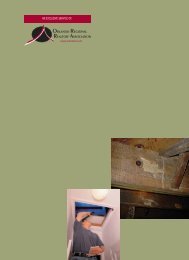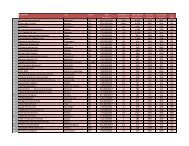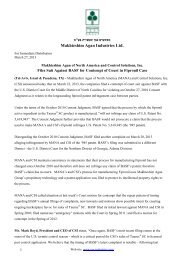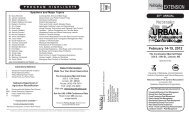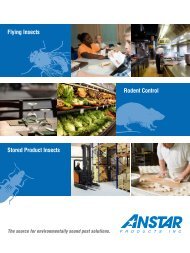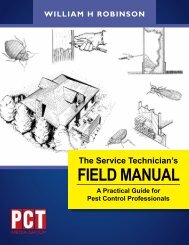PPMA - Pest Control Technology
PPMA - Pest Control Technology
PPMA - Pest Control Technology
You also want an ePaper? Increase the reach of your titles
YUMPU automatically turns print PDFs into web optimized ePapers that Google loves.
The Proactive Voice of the<br />
<strong>Pest</strong> Management Industry<br />
Celebrating 15 years // 1997 – 2012
Celebrating 15 Years of <strong>PPMA</strong><br />
By Jodi Dorsch<br />
The Professional <strong>Pest</strong> Management Alliance (<strong>PPMA</strong>) is 15<br />
years old, which, if it were a person, would make it one<br />
year shy from getting its driver’s license. But that doesn’t<br />
mean <strong>PPMA</strong> hasn’t been driving the public’s perception<br />
about the professional pest management industry for the past decade<br />
and a half.<br />
For 15 years, the marketing and public relations arm of the<br />
National <strong>Pest</strong> Management Association has been proactively<br />
reaching out to the media to tell your story — the story of the<br />
pest management professional. <strong>PPMA</strong> has taken on the task of<br />
explaining exactly what pest management professionals do and<br />
why they do it. The group has been educating the media and consumers<br />
about the threats posed by the pests you control every<br />
day, while at the same time serving as a media resource when a<br />
negative story hits the airwaves or the Web.<br />
Whenever you see a mention of cockroaches, rats, bed bugs<br />
and other pests on a day-time talk show, in a national magazine<br />
or in a daily newspaper, chances are <strong>PPMA</strong> has talked to the re-<br />
porter or producer in some way as an<br />
expert resource. And just because you<br />
don’t see NPMA’s name in the piece<br />
doesn’t mean the staff didn’t participate;<br />
it may have been “behind the scenes”<br />
work, like supplying statistics, providing the names of local PMPs<br />
to be interviewed or even helping out with photographs or video.<br />
If you are unfamiliar with <strong>PPMA</strong>, I hope this supplement<br />
serves as a resource and that you take a few moments to learn<br />
more about the group and its mission. I urge you to visit www.<br />
npmapestworld.org/ppma to find out how you can help improve<br />
the impression of your industry in the minds of both residential<br />
and commercial consumers.<br />
PCT is proud to produce this special supplement honoring<br />
the work the Professional <strong>Pest</strong> Management Alliance has done<br />
throughout the past 15 years, and we thank the advertisers for<br />
supporting this piece. PCT looks forward to another successful<br />
15 years supporting <strong>PPMA</strong> and its mission!<br />
CONTENTS<br />
4 <strong>PPMA</strong> Celebrates 15 Years Advocating for the <strong>Pest</strong> <strong>Control</strong> Industry<br />
The Professional <strong>Pest</strong> Management Alliance has helped to grow the market by<br />
more than 9 million new customers since 1997.<br />
10<br />
12<br />
6 How is <strong>PPMA</strong> Growing the Market?<br />
Whether it’s PSAs, paid advertising or media relations in print and online,<br />
<strong>PPMA</strong> works hard to reach consumers wherever they may be.<br />
10 A New Voice for <strong>PPMA</strong><br />
In May, <strong>PPMA</strong> named Loyola University’s Dr. Jorge Parada as its medical<br />
spokesperson to help better communicate medical risks and treatments associated<br />
with pests.<br />
12 <strong>Pest</strong>World Asks, ‘Show Us Your Scream’<br />
<strong>PPMA</strong>’s <strong>Pest</strong>World.org joins the Facebook arena with a contest asking folks to<br />
show their best reactions upon seeing an unwanted pest, and boosts its reach<br />
among consumers.<br />
14 <strong>Pest</strong>World.org Gets a Makeover Inside and Out<br />
<strong>PPMA</strong> turns a site redesign into an opportunity to rethink the visitor experience.<br />
<strong>PPMA</strong> 15 th Anniversary Supplement 3
<strong>PPMA</strong> Celebrates 15 Years<br />
Advocating for the <strong>Pest</strong> <strong>Control</strong> Industry<br />
<strong>PPMA</strong> has helped to grow the market by more than 9 million new customers since 1997.<br />
“I’ve been so<br />
appreciative<br />
of what they do<br />
for us as an<br />
industry. They<br />
raised the bar<br />
(and) they’ve<br />
raised the<br />
level of<br />
professionalism<br />
in our industry.”<br />
Stuart Aust,<br />
President,<br />
Bug Doctor Termite<br />
& <strong>Pest</strong> <strong>Control</strong>,<br />
Paramus, N.J.<br />
Until the National Pork Board started advertising,<br />
most people didn’t know pork<br />
as “the other white meat.” Before the<br />
California Milk Advisory Board, later<br />
known as the California Milk Processor Board,<br />
took out full-page advertisements of celebrities<br />
sporting milk mustaches, many American’s didn’t<br />
know that “milk does a body good.” These two<br />
campaigns illustrate the strength professional industries<br />
can have when united in educational outreach<br />
to consumers.<br />
While nowhere near the size of these monster<br />
programs, which spent nearly $100 million collectively<br />
to communicate their messages, the pest<br />
management industry’s own Professional <strong>Pest</strong><br />
Management Alliance (<strong>PPMA</strong>) has been working<br />
since 1997 to make significant strides in educating<br />
the public about the vital role the industry has<br />
in protecting against the diseases and dangers of<br />
pests. About 10 years ago, fewer than 18 percent of<br />
homeowners reported using professional pest control.<br />
In 2011, that number has grown to 30 percent<br />
— more than 9 million new pest control customers.<br />
<strong>PPMA</strong>’s marketing efforts, combined with the work<br />
done by individual companies, are contributing to<br />
the industry’s overall growth.<br />
What is <strong>PPMA</strong>? <strong>PPMA</strong> is the marketing arm<br />
of the National <strong>Pest</strong> Management Association<br />
(NPMA). NPMA’s efforts are focused on impor-<br />
tant tasks such as providing quality education and<br />
training and supporting public policy initiatives.<br />
By design, creating a voice for the industry and<br />
supporting the industry’s growth in the United<br />
States are functions assigned to <strong>PPMA</strong>. No NPMA<br />
dues dollars support <strong>PPMA</strong>’s work. Rather, voluntary<br />
investments from companies committed to<br />
the industry’s future provide nearly $2 million in<br />
annual funding to enable its marketing and communications<br />
initiatives.<br />
Originally called the Industry Awareness Council<br />
(IAC), members of the National <strong>Pest</strong> <strong>Control</strong><br />
Association (now NPMA) formed a committee<br />
in 1997, which was chaired by industry veteran<br />
Harvey Massey. The IAC grew into its own organization<br />
with its own Board of Directors and operating<br />
budget in 1998 as it began developing and<br />
executing its own public relations campaign.<br />
Today, <strong>PPMA</strong> executes a comprehensive marketing<br />
program designed to grow, protect and defend<br />
the industry and to educate the public about<br />
pests through extensive media relations outreach,<br />
television and radio public service announcements,<br />
online advertising, social media engagement, online<br />
initiatives and more. Last year, the organization’s<br />
message (which is all promoted to the consumer<br />
audience under the name of NPMA) was<br />
heard more than 1 billion times through TV and<br />
radio airings, local and national newspaper articles,<br />
consumer and commercial magazines, and more.<br />
Proactively Protecting the Industry<br />
One of the foundational cornerstones that led to the<br />
creation of <strong>PPMA</strong> was the importance of the industry<br />
having a unified voice to speak up about important<br />
pest issues and to speak on behalf of the industry<br />
as an advocate. With the creation of the organization,<br />
consumers no longer had to learn about pest<br />
management from activists and critics alone. <strong>PPMA</strong><br />
has ensured the industry is not in a reactive mode<br />
to negative circumstances, but rather in a proactive<br />
mode of promoting the positive aspects of the industry.<br />
When needed, <strong>PPMA</strong> will respond to inaccurate<br />
misrepresentations or issue crisis communications<br />
talking points, but fortunately, <strong>PPMA</strong> mostly operates<br />
in a proactive posture.<br />
4 <strong>PPMA</strong> 15 th Anniversary Supplement
How is<br />
<strong>PPMA</strong><br />
Growing<br />
the<br />
Market?<br />
[<br />
Whether it’s PSAs, paid advertising<br />
or media relations in print and online,<br />
<strong>PPMA</strong> works hard to reach consumers<br />
wherever they may be.<br />
How does <strong>PPMA</strong> raise consumer awareness of diseases<br />
and dangers of pests? How does <strong>PPMA</strong> encourage<br />
the use of qualified and licensed PMPs over<br />
less credible companies and DIY options? <strong>PPMA</strong><br />
achieves both objectives through initiatives that fall<br />
into four major categories:<br />
1Media Relations<br />
Generating stories on pest management nationally,<br />
regionally and locally, and positioning<br />
the industry in a positive light.<br />
2Online Communications<br />
Developing and maintaining consumer<br />
websites including www.pestworld.org,<br />
www.pestworldforkids.org, www.allthingsbed<br />
bugs.org, www.kidcrittercrafts.org, www.whatis<br />
ipm.org and an active social media presence on<br />
Facebook, Twitter and most recently on Pinterest.<br />
3Public Service Announcements<br />
Messages air in donated commercial space<br />
on TV and radio stations throughout the<br />
country, reminding customers of the health and<br />
property risks posed by pests.<br />
4Advertising<br />
Targeted banner advertising on highly trafficked<br />
websites frequented by consumers<br />
who fit key demographics.<br />
What follows is a review of these four initiatives. >><br />
6 <strong>PPMA</strong> 15 th Anniversary Supplement
1. Connecting with Consumers through Media Relations<br />
One of the most visible ways <strong>PPMA</strong> connects with<br />
the public is through generating stories all across<br />
the country about professional pest control and<br />
related issues. In the early days, the organization’s<br />
leaders were excited if a reporter in Small Town,<br />
USA, saw the value in a possible bug story and<br />
returned a phone call. Now, with a decade and a<br />
half of service under its belt as a credible resource,<br />
<strong>PPMA</strong> has become a go-to source for journalists<br />
across the country.<br />
In 2011, for example, the organization participated<br />
in more than 2,000 pest-oriented stories and<br />
spurred the initiation of countless others. Every<br />
day, the industry’s PR team pitches pest story ideas<br />
to editors and producers in the top 250 U.S. media<br />
markets. Although seasonality can play a key role<br />
in pest news, sometimes it’s the oddities of rodents,<br />
bugs and insects that drive interest. Regardless of<br />
the focus, <strong>PPMA</strong> regularly provides journalists<br />
with staff experts or local pest professionals to create<br />
a “buzz” about pest news.<br />
The first early PR win for the industry’s voice<br />
came in 2000 when NPMA’s former Technical Director<br />
Greg Baumann appeared on NBC’s “Today<br />
Show.” Reaction from the industry was overwhelmingly<br />
positive and it was a huge boost to the group’s<br />
morale. Since that time, <strong>PPMA</strong> has appeared on<br />
When <strong>PPMA</strong> was first founded, no one could have<br />
predicted how important online communications<br />
would be to an organization’s visibility. Only a crystal<br />
ball could have forecasted the importance of<br />
search engine optimization or comprehended the<br />
power of social media platforms — or even just a<br />
good, usable website. Today, online communication<br />
is an essential ingredient to the group’s success<br />
in reaching an engaged audience.<br />
<strong>PPMA</strong> is responsible for three consumer sites:<br />
<strong>Pest</strong>World.org, <strong>Pest</strong>Worldforkids.org, and Whatis<br />
IPM.org and several micro-sites: AllThingsBed-<br />
Bugs.org, KidCritterCrafts.com and <strong>Pest</strong>World.<br />
org/<strong>Pest</strong>Quest. More than 1 million unique visitors<br />
found their way to these sites last year and more are<br />
expected to this year with an overhauled site design<br />
and SEO initiatives supporting <strong>Pest</strong>World.org<br />
(see page 14). Most every media interview done by<br />
<strong>PPMA</strong>, every ad placed and every PSA aired directs<br />
viewers to one of these sites for ample educational<br />
materials and pest news, as well as access to<br />
the program, now simply known as “Today” 10<br />
more times, in addition to numerous national TV<br />
appearances on “The Dr. Oz Show,” “The Rachael<br />
Ray Show,” MSNBC, CBS “The Early Show,” The<br />
Weather Channel, The History Channel’s “Modern<br />
Marvels,” and in an endless list of coverage in national<br />
publications including People, Real Simple,<br />
Better Homes and Gardens, Time, The Wall Street<br />
Journal, USA Today and more. While national audiences<br />
are important, so too are the stories the organization<br />
generates in hundreds of small towns.<br />
That is why the group dedicates time and resources<br />
to pitching in smaller markets and providing content<br />
specific to community papers.<br />
In addition to its communications to homeowners,<br />
much attention has also been given to educating<br />
commercial audiences. It’s been a particularly<br />
important objective in recent years, as economic<br />
conditions have encouraged some companies to<br />
control costs by reducing their pest control operations.<br />
With <strong>PPMA</strong>-written articles, the industry<br />
has taken a leadership role to help businesses<br />
understand the potential consequences of poundwise,<br />
penny-foolish decisions. Last year, <strong>PPMA</strong><br />
generated messages reached a collective audience<br />
of more than 2 million in commercial-oriented<br />
publications.<br />
2. Connecting with Consumers through Online Communications<br />
qualified and licensed NPMA member companies<br />
in its ZIP code locator.<br />
Many are surprised to learn <strong>PPMA</strong> invests so<br />
heavily in online outreach to children. <strong>PPMA</strong>’s robust<br />
children’s website, <strong>Pest</strong>WorldForKids.org, featuring<br />
games and lesson plans for the classroom,<br />
“<strong>Pest</strong> Quest,” a web-based children’s show offering<br />
teachable pest facts and interactive quizzes (it’s also<br />
available OnDemand in 31 million homes), Critter<br />
Crafts video segments showing step-by-step instructions<br />
on fun kid crafts, and now the new children’s<br />
ebook, “The <strong>Pest</strong> Detectives,” <strong>PPMA</strong>’s Board<br />
of Directors has made quite an investment in fostering<br />
a relationship with tomorrow’s<br />
pest control buyers and future<br />
industry professionals. There’s<br />
recognition that interaction<br />
with the kids of today usually<br />
involves their parents<br />
too, offering dual reach and<br />
immediate impact.<br />
Selected<br />
Media<br />
Placements<br />
• Nightline<br />
• The Today Show<br />
• Dr. Oz<br />
• Rachael Ray<br />
• The Revolution<br />
• NBC Nightly News<br />
• CBS Early Show<br />
• Dateline<br />
• People<br />
Magazine<br />
• Real Simple<br />
• Men’s Health<br />
• Time<br />
• U.S. News and<br />
World Report<br />
• Shape<br />
• USA Today<br />
• Wall Street Journal<br />
• American School<br />
& Hospital Facility<br />
• Quality Assurance<br />
& Food Safety<br />
• Today's Facility<br />
Manager<br />
• American School<br />
& University<br />
• Buildings and<br />
Sanitary<br />
Maintenance<br />
Magazine
“<strong>PPMA</strong>’s most<br />
important<br />
function is to<br />
support and<br />
elevate the<br />
brand of our<br />
industry and<br />
the pest<br />
management<br />
professional.<br />
<strong>PPMA</strong><br />
continues to<br />
provide a<br />
consistent<br />
message about<br />
who we are and<br />
what we do.”<br />
Cleveland Dixon Jr.,<br />
Holiday Termite<br />
and <strong>Pest</strong> <strong>Control</strong>,<br />
Springfield, Va.<br />
3. Connecting with Consumers through<br />
Public Service Announcements<br />
Still photos from <strong>PPMA</strong>’s “Trust Your Instincts” PSA,<br />
in which people don’t do as instructed and are<br />
surprised (and scared!) at what they find.<br />
Because of NPMA’s non-profit designation, it’s able<br />
to run public service announcements (PSAs) on<br />
television and radio without having to purchase<br />
the airtime. Networks donate space and select the<br />
messages that will be heard and the ones that will<br />
be ignored. This seems easy enough, but with limited<br />
space available, it is a highly competitive landscape<br />
and campaigns need to stand out.<br />
Last year, <strong>PPMA</strong>-produced PSAs aired nearly<br />
125,000 times, equating to more than 1,000 hours<br />
of airtime. All 30- and 60-second spots advise<br />
viewers and listeners about the diseases and dangers<br />
associated with common household pests.<br />
From the sobering “Emergency Room” that offers<br />
a doctor’s perspective on the health implications of<br />
pests to the comical two-part series “Least Wanted”<br />
and “Interrogation,” which features actors dressed<br />
as a cockroach, bed bug and mouse, to this year’s<br />
“Trust Your Instincts,” that looks at people’s natural<br />
reaction to pests, <strong>PPMA</strong>’s award-winning PSAs are<br />
widely supported by PSA directors of national networks<br />
and local affiliates across the country.<br />
Combining the important messaging offered by<br />
PSAs with the group’s ongoing commitment to science<br />
education, <strong>PPMA</strong> has invited students to write and produce their own pest-related PSAs for an annual<br />
award of $3,000 to be put toward the winning school’s science program (see page 13).<br />
Trust a Professional: <strong>PPMA</strong> Adds Another Industry Tool to its Video Series<br />
Everyone has professional advisors in their lives — those who<br />
are essentially strangers from a personal perspective that consumers<br />
trust whole-heartedly with their most valuable assets.<br />
Family physicians safeguard one’s health, financial advisors<br />
protect and (hopefully) grow retirement funds and attorneys hold<br />
a person’s fate in their hands by arguing a case or providing<br />
legal counsel. Of course there are countless other professionals<br />
who consumers depend on to help them live safely. As those in<br />
the industry can attest, pest management professionals serve<br />
in this very same capacity. Homeowners depend on pest<br />
management technicians to keep their families and properties<br />
safe from the diseases and dangers of pests.<br />
To tell this compelling story, <strong>PPMA</strong> funded the development<br />
of a new video in its “Pride and Professionalism”<br />
series. “Trust a Professional” is an illustrative depiction of a<br />
pop-up storybook. Told from a mother’s perspective, the narrator<br />
explains why she made the choice to partner with a pest<br />
8 <strong>PPMA</strong> 15 th Anniversary Supplement
4. Connecting with Consumers through<br />
Ad Campaigns<br />
<strong>PPMA</strong> has long targeted women older than 35 with its ad campaign messaging,<br />
also focusing on married mothers. Its research has shown those who<br />
fit these demographics are often heavily involved in decision-making about<br />
home service providers and see the value in using professional pest control to<br />
protect their homes and families.<br />
The ways in which <strong>PPMA</strong> has reached out to this audience has changed<br />
over time. Until 2009, <strong>PPMA</strong> had a heavy investment in radio advertising,<br />
trying to reach listeners during drive time and those at home during the day.<br />
Several years ago — in keeping with how consumers were more likely to receive<br />
and act upon information — <strong>PPMA</strong> decided to eliminate all radio advertising<br />
and move its ad buy into online advertising. For the past several<br />
years, banner ads have run on popular sites including FoxNews.com, People.<br />
com, Weather.com, iVillage.com, AOL.com and many more. <strong>PPMA</strong>’s banners<br />
deliver 35 million impressions each year during the start of pest season, running<br />
from mid-March to July.<br />
In 2012, <strong>PPMA</strong> began testing the returns of Facebook advertising for the<br />
first time. Ad buys were used to encourage consumers to follow NPMA’s consumer<br />
presence on Facebook. <strong>PPMA</strong> launched the consumer <strong>Pest</strong>World page<br />
in mid-June and tied it to a Facebook video and photo contest (see page 12),<br />
the campaign yielded an average of 300 to 500 new followers per day, driving<br />
the amount of “likes” up past 20,000 in less than two months’ time.<br />
<strong>PPMA</strong> has long targeted<br />
women older than 35 with its<br />
ad campaign messaging, also<br />
focusing on married women<br />
who are mothers.<br />
professional to help protect her family. “We used humor, dynamic<br />
movement and a strong narrative to help viewers learn just<br />
how important it is to entrust a professional with the protection<br />
of their family, home and health,” said Missy Henriksen, executive<br />
director of <strong>PPMA</strong>. “Aside from our own consumer education<br />
initiatives, the video is also an excellent resource for companies<br />
to use in their own customer communications and can even be<br />
used as part of employee training programs.”<br />
“Trust a Professional” is another tool in the <strong>PPMA</strong> arsenal<br />
designed to help the group continue its quest to enhance the image<br />
and recognition of professionalism in the industry. In appreciation<br />
of the investors who funded this project, a digital version<br />
of the video is available for download as part of the <strong>PPMA</strong> Perks<br />
program. Companies can insert their own logos and contact<br />
information on the book cover shown in the video and offer it on<br />
their websites for an individually branded communications and<br />
training piece.<br />
More Committed<br />
PMPs Needed<br />
With just shy of 300 investors, only<br />
about 10 percent of NPMA’s U.S.<br />
membership supports <strong>PPMA</strong>, yet all<br />
pest companies reap the benefits of<br />
a growing market and a strong industry<br />
voice. <strong>PPMA</strong>’s leadership is<br />
hopeful more companies will unite<br />
in the efforts to promote the industry.<br />
If 300 companies can enable the<br />
incredible successes that have been<br />
demonstrated so far, imagine what<br />
could be accomplished if <strong>PPMA</strong>’s<br />
roster were to double or even triple.<br />
While most companies that support<br />
<strong>PPMA</strong> do so for altruistic reasons,<br />
some also do so for the benefits<br />
(or “<strong>PPMA</strong> Perks”) that are<br />
offered to those that invest. For<br />
instance, <strong>PPMA</strong> investors receive<br />
numerous resources that can support<br />
their own company’s marketing<br />
efforts. Items such as customizable<br />
press releases, local media lists, b-<br />
roll and photography, customizable<br />
TV and radio ads, exclusive consumer<br />
and industry research reports<br />
and media talking points can be incredibly<br />
valuable.<br />
Current investors contribute anywhere<br />
between $250 a year to annual<br />
contributions that are well into<br />
the six-figure range. Each donation<br />
is valued and appreciated as it helps<br />
support the industry’s long-term<br />
goals and protects the industry in<br />
the future. Together, the industry will<br />
move forward.<br />
If your company is<br />
not yet investing<br />
and you would like<br />
to learn more about<br />
how you can further<br />
support the industry,<br />
contact <strong>PPMA</strong> Executive Director,<br />
Missy Henriksen at 703/352-6762<br />
or mhenriksen@pestworld.org.
In May, <strong>PPMA</strong><br />
named Loyola<br />
University’s<br />
Dr. Jorge<br />
Parada as<br />
its medical<br />
spokesperson<br />
to help better<br />
communicate<br />
medical risks<br />
and treatments<br />
associated<br />
with pests.<br />
By Bill Delaney<br />
A New Voice for <strong>PPMA</strong><br />
In an effort to streamline communications between<br />
<strong>PPMA</strong> and the public regarding health<br />
risks posed by pests, the organization this past<br />
May retained a new medical spokesperson — and<br />
the man with the job says he sees his new role as an<br />
important one.<br />
“I think my main purpose is to add medical<br />
background to the discussions about how we<br />
should react, what are the things we need to watch<br />
for, when we’re dealing with, for lack of a better<br />
term, pests,” said Dr. Jorge Parada, medical director<br />
of the Loyola University Medical System Infection<br />
<strong>Control</strong> Program in Chicago, Ill., an associate<br />
professor of medicine at Loyola’s Stritch School of<br />
Medicine and <strong>PPMA</strong>’s new medical spokesperson.<br />
“The truth is, there are common encounters we<br />
have with mosquitoes, bees, ticks and unfortunately,<br />
they can have medical repercussions.”<br />
Parada has assisted <strong>PPMA</strong>’s media and consumer<br />
relations efforts as a medical authority in communicating<br />
those health risks, and pens a column<br />
for www.pestworld.org, <strong>PPMA</strong>’s consumer website.<br />
He said the partnership was forged through a combination<br />
of timing and luck. “I think the NPMA<br />
has long felt comfortable advising in things that can<br />
be done to reduce some of the exposure risks, and<br />
how to manage some of the problems with these<br />
different organisms. They felt a bit less comfortable<br />
talking about some of the real medical effects and<br />
consequences of these encounters.”<br />
Parada said the expertise he provides for the<br />
organization comes through training and experience.<br />
“Everything that I say is coming from my<br />
“<br />
Everything that I say is<br />
coming from my professional<br />
training and is guided by my best<br />
understanding of what the facts<br />
are, not influenced by NPMA, or<br />
any of its specific ties. I do my<br />
best to give straight-up information<br />
and call it as I see it, and that’s<br />
what they want from me.”<br />
— Dr. Jorge Parada<br />
professional training and is guided by my best understanding<br />
of what the facts are, not influenced by<br />
NPMA, or any of its specific ties,” he said. “I do my<br />
best to give straight-up information and call it as I<br />
see it, and that’s what they want from me.”<br />
Parada has an extensive background that allows<br />
him to be an authoritative medical spokesperson<br />
for <strong>PPMA</strong>, and he said public health has long been<br />
important to him. “It took me a while to decide I<br />
wanted to go into medicine. I went in with a simultaneous<br />
love of trying to understand what it is in<br />
society that leads to certain outcomes. In medicine,<br />
that translated in my mind into understanding<br />
infectious diseases, where transmission has to<br />
do with the society you live in, crowding, poverty,<br />
sanitation, vaccination problems.”<br />
Parada received his bachelor of arts degree in<br />
social sciences from the State University of New<br />
York at Stony Brook, his master’s of public health<br />
from Harvard University and his doctorate in medicine<br />
from Lisbon Medical School in Portugal. He<br />
has completed an infectious diseases fellowship at<br />
Boston University and a health services research<br />
outcomes fellowship at Rush University and Cook<br />
County Hospital in Chicago. He also has served as<br />
course director for the Chicago Medical Society<br />
and the Chicago Department of Public Health’s<br />
programs on emergency preparedness for bioterrorism,<br />
pandemic influenza and severe acute respiratory<br />
syndrome (SARS).<br />
“<strong>PPMA</strong> is thrilled to have Dr. Parada as our<br />
medical spokesperson,” said Missy Henriksen,<br />
executive director of <strong>PPMA</strong>. “We are often asked<br />
about specific medical conditions<br />
and treatments as related<br />
to pests and their effects, but<br />
are not able to offer such advice.<br />
With the addition of Dr.<br />
Parada, we are able to provide<br />
not just entomological perspectives,<br />
but medical ones as<br />
well as we continue our efforts<br />
to educate the media and the<br />
public about the diseases and<br />
dangers of pests.”<br />
The author is associate editor of<br />
PCT magazine. Contact him via<br />
email at bdelaney@giemedia.<br />
com.<br />
10 <strong>PPMA</strong> 15 th Anniversary Supplement
<strong>PPMA</strong>’s <strong>Pest</strong>World.org joins<br />
the Facebook arena with a<br />
contest asking folks to show<br />
their best reactions upon seeing<br />
an unwanted pest, and boosts<br />
its reach among consumers.<br />
<strong>Pest</strong>World Asks,<br />
By Bill Delaney<br />
‘Show Us Your Scream’<br />
This past summer, the Professional <strong>Pest</strong> Management<br />
Alliance (<strong>PPMA</strong>) had a special request<br />
for consumers: “Show Us Your Scream.”<br />
Via Facebook, <strong>PPMA</strong> sought to engage consumers<br />
with its “Show Us Your Scream” contest,<br />
which challenged readers to display their finest<br />
reactions upon seeing an unwanted pest. <strong>PPMA</strong><br />
Executive Director Missy Henriksen said the initiative’s<br />
goal was for the organization to dip its toes<br />
into Facebook, which had prior been uncharted<br />
territory for the organization.<br />
“I think from <strong>PPMA</strong>’s perspective, we are always<br />
looking for ways to reach out to consumers,”<br />
said Henriksen. “We look for new ways to engage<br />
with consumers and help them see our messaging.”<br />
In terms of consumer visibility for <strong>PPMA</strong>, the<br />
effort was a success. The <strong>Pest</strong>World.org Facebook<br />
page now has near 21,000 “likes,” and Henriksen<br />
credits the “Show Us Your Scream” contest as a<br />
driver for that growth.<br />
“It was conceptualized as a fun way to reach<br />
out to people,” Henriksen said. “It started with us<br />
creating a Facebook page. For years we had elected<br />
not to — we thought it made sense for consumers<br />
to follow individual pest management companies,<br />
but why would they want to follow our industry?<br />
But because we needed to run that contest through<br />
some sort of social media platform, we reversed<br />
that line of thinking.”<br />
The winner of the contest, Cori G., of New Jersey,<br />
was chosen by Facebook voters from a pool of<br />
about 50 entrants who submitted both photos and<br />
videos, was awarded a paid trip to an amusement<br />
park of their choice. More than 1,500 votes were<br />
cast<br />
“The contest was used as a catalyst to build a<br />
relationship with those people, and Facebook was<br />
a way to make it happen,” Henriksen said, adding<br />
that the initiative exceeded expectations. “The contest<br />
itself isn’t the key takeaway. That will come and<br />
go. The key goal is developing a relationship with<br />
consumers. The fact we have all these folks we’ll<br />
continue to engage with long after the contest is<br />
over, I’m absolutely thrilled.”<br />
Henriksen said that based on the success the<br />
contest, <strong>PPMA</strong> will likely launch a similar initiative<br />
sometime in the next year.<br />
“I think a lot of people are hesitant to dive into<br />
social media, because it’s unmapped territory,”<br />
Henriksen said. “It’s been great to see how different<br />
companies are using it. I think the industry is very<br />
good about sharing with one another, both their<br />
successes and lessons learned, so it’s great to see.”<br />
The author is associate editor of PCT magazine.<br />
Contact him at bdelaney@giemedia.com.<br />
“The contest<br />
itself isn’t the<br />
key takeaway.<br />
That will come<br />
and go. The<br />
key goal is<br />
developing a<br />
relationship with<br />
consumers. The<br />
fact we have all<br />
these folks<br />
we’ll continue<br />
to engage with<br />
long after the<br />
contest is over,<br />
I’m absolutely<br />
thrilled.”<br />
– Missy Henriksen<br />
12 <strong>PPMA</strong> 15 th Anniversary Supplement
Schools Invited To Particpate<br />
In National PSA Contest<br />
<strong>PPMA</strong> has announced the fourth annual “<strong>Pest</strong> PSA<br />
Contest” on its educational children’s website,<br />
www.pestworldforkids.org. The national contest<br />
challenges students in grades 4 through 8 to create<br />
their own educational television public service announcement<br />
that highlights the health and property<br />
risks posed by common household pests such as<br />
rodents, ants, termites, cockroaches, stinging insects<br />
and bed bugs.<br />
Using the <strong>Pest</strong> PSA lesson plan available on<br />
www.pestworldforkids.org, teachers are able to assign<br />
students the task of creating 30- or 60-second<br />
television PSAs. The contest ends on Dec. 21, 2012.<br />
“We have been thrilled with the success of this<br />
contest over the past three years and are excited<br />
to offer one of our key<br />
audiences — students<br />
and young children —<br />
yet another opportunity<br />
to learn about the importance<br />
of pest management,”<br />
said Missy Henriksen, executive director<br />
of <strong>PPMA</strong>. “We’re asking companies to help us<br />
spread the word about this contest and encourage<br />
the schools within their service areas to participate.<br />
The ‘<strong>Pest</strong> PSA Contest’ is a great way to support<br />
science education during a time when many school<br />
budgets are being cut.”<br />
One school will be recognized as the grand prize<br />
winner and will receive a $3,000 award for their<br />
school’s science department.<br />
For contest rules visit www.pestworldforkids.org.<br />
<strong>PPMA</strong> 15 th Anniversary Supplement 13
<strong>Pest</strong>World.org<br />
Gets a Makeover Inside and Out<br />
<strong>PPMA</strong> turns a site redesign into an opportunity to rethink the visitor experience.<br />
Homepage<br />
Find a pro<br />
<strong>Pest</strong> TV<br />
For nearly a decade, <strong>Pest</strong>World.org<br />
has been the hub of <strong>PPMA</strong>’s efforts<br />
to educate consumers about pests.<br />
Media placements, public service<br />
announcements and advertisements all<br />
direct consumers to visit the site for more<br />
information, or to locate a local pest professional<br />
and NPMA member company.<br />
But in late 2011 the site, which was last<br />
redesigned in 2008, had reached its capacity<br />
from a content perspective and the<br />
look was becoming dated. It was time for<br />
an overhaul.<br />
Rather than just giving the site a new<br />
look, <strong>PPMA</strong> took the opportunity to<br />
completely re-conceptualize the visitor<br />
experience. The new site, which was unveiled<br />
in February 2012, took its inspiration<br />
from sites like WebMD and Prevention.com.<br />
Articles and other content are<br />
now developed exclusively for www.pest<br />
world.org, and rotate on a monthly basis<br />
in conjunction with an editorial calendar<br />
and a “pest of the month.”<br />
“Our goal in redesigning <strong>Pest</strong>World.<br />
org was to make it a one-stop resource<br />
for consumers in search of pest-related<br />
topics,” says Missy Henriksen, executive<br />
director of <strong>PPMA</strong>. “We wanted to provide<br />
a more interactive, engaging experience,<br />
and ensure that the information<br />
consumers are seeking is easy to find and<br />
helpful.”<br />
The new site features articles and<br />
content from an array of expert sources.<br />
Henriksen writes a regular blog called<br />
“The Bug Lady,” which is designed to<br />
connect viewers, especially mothers and<br />
busy professionals, with useful, relatable<br />
information. The new “Guest Columnist”<br />
section features outside industry sources,<br />
such as realtors, home inspectors and<br />
government agencies. Dr. Jorge Parada,<br />
NPMA’s medical expert, also routinely<br />
contributes content for the “Health Hub”<br />
on pest-related health issues, including<br />
salmonella, Lyme disease, West Nile virus,<br />
hantavirus, and asthma and allergies.<br />
In June, for example, the site’s theme<br />
focused on stinging and biting summer<br />
pests. Articles included “Summer’s<br />
Most Dangerous <strong>Pest</strong>s,” “Keeping Your<br />
Backyard BBQ <strong>Pest</strong>-Free” and “Stinging<br />
Insects 101: How to Identify the Nest,<br />
the <strong>Pest</strong> and the Threat.” Dr. Parada<br />
contributed an article about the health<br />
risks posed by summer pests, and “The<br />
Bug Lady” blog offered some fun “critter<br />
craft” ideas for families looking to combat<br />
summertime boredom. By July, the<br />
content had switched gears entirely to<br />
focus on bed bugs.<br />
“By publishing timely content to each<br />
section of the site monthly, <strong>Pest</strong>World.<br />
org always remains fresh and relevant,<br />
and visitors are more likely to return on a<br />
regular basis,” Henriksen explains.<br />
Other new features on <strong>Pest</strong>World.org<br />
include a live @<strong>Pest</strong>World Twitter feed<br />
14 <strong>PPMA</strong> 15 th Anniversary Supplement
and a multimedia page with a library of<br />
pest photography, <strong>Pest</strong>101 videos, PSAs<br />
and NPMA’s educational videos.<br />
<strong>Pest</strong>World.org feeling empowered to<br />
tackle pests, by taking preventative measures<br />
around the house to help keep them<br />
out and by partnering with an NPMA<br />
member company to help effectively and<br />
safely remediate infestations,” says Henriksen.<br />
“We feel confident that the redesign<br />
has accomplished that!”<br />
CLASSIC CONTENT TOO. Despite its<br />
new look, <strong>Pest</strong>World.org retains many<br />
of its popular features, including the <strong>Pest</strong><br />
Guide, AllThingsBedBugs microsite, media<br />
gallery and Extreme Infestations case<br />
studies. The Find-A-Pro ZIP code locator,<br />
which helps users find pest professionals<br />
in their local communities, also got<br />
a face-lift and a prominent home on the<br />
new site.<br />
“It is worth noting that <strong>PPMA</strong> investors<br />
receive four times more clickthroughs<br />
from the ZIP code locator than<br />
non-investors,” says Henriksen. “We’re<br />
seeing firsthand that the denotation recognizing<br />
their involvement in <strong>PPMA</strong> is<br />
meaningful to potential customers.”<br />
With the site redesign complete,<br />
<strong>PPMA</strong> embarked upon expanded search<br />
engine optimization (SEO) efforts. “Our<br />
consumer sites were attracting more than<br />
1 million unique visitors per year but we<br />
believed more could be done to help consumers<br />
find information and pest professionals<br />
in their area,” Henriksen explains.<br />
With the help of an outside firm,<br />
<strong>PPMA</strong> took a deep dive into the strengths<br />
and weaknesses of the site and developed<br />
a thorough strategy plan.<br />
“Our work has included one-time<br />
changes like tagging photo and video<br />
content to correspond with keywords that<br />
consumers are searching for, and longterm<br />
learnings like how to write content<br />
that will best correspond with consumer<br />
searches,” says Henriksen.<br />
Though the SEO work is still underway,<br />
www.pestworld.org has already seen<br />
a 42 percent increase in site traffic, Henriksen<br />
reports.<br />
“We attribute the increase in site traffic<br />
to a combination of factors,” says Henriksen.<br />
“Certainly, the SEO program has<br />
had a huge impact. And, the site redesign,<br />
with its modern layout, easy navigation,<br />
vivid photography and strengthened content<br />
has had a positive impact as well.”<br />
The result?<br />
“We always want homeowners to leave See me at NPMA <strong>Pest</strong>world call (404)556-4365<br />
<strong>PPMA</strong> 15 th Anniversary Supplement 15



